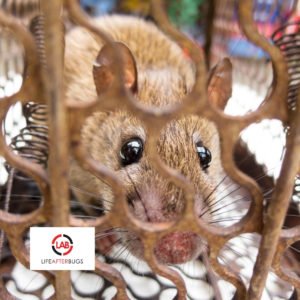Mice may be fuzzy little mammals that some people keep as pets. But they’re also an incredible nuisance when wild. They can destroy crops, contaminate food supplies, and carry diseases into homes and businesses. It’s not easy getting rid of mice — those fast and elusive little pests. They produce large litters of 6-8 pups. Those young are fully grown and ready to have litters of their own in just six weeks. Females can have a litter up to 10 times a year.
Mice are breeding machines. But there are some practical ways to get rid of them.
What Not to Use
Before we provide tips to get rid of mice on a budget, let’s talk about what you should never use in or around your home in an attempt to get rid of mice or rodents; poison. Please, don’t put your children, pets, and outdoor wildlife at risk with rat poison. It’s not safe.
1. Use Mouse Traps

The traditional snap trap is the most affordable and convenient. Despite how it looks, it’s quick and painless. But someone will need to pry the mouse out to discard it after successful trapping. And it should not be used if children are around–or overly curious, risk-taking adults.
Electronic traps catch mice in a container without harming them. These traps then alert you when one is caught. You can choose to let that mouse out somewhere unharmed. But unless you take the trap out to a field or woodland away, far away from the house, it will come right back in.
The trap only becomes an inconvenience to the mouse.
You can combine a catch and release trap with an ultrasonic sound emitter that produces a sound that you can’t hear. But the rodent can’t stand it. You might be wondering if your pet can hear it. These devices are designed to emit sound within a narrow range that only rodents can hear.
However, if you have a hamster, guinea pig, chinchilla, or other rodent pet, they may be able to hear the annoying sound, and this type of device should generally be avoided.
2. Choose Bait Rodents Can’t Resist
Mice like high calories foods. These tend to be denser foods like nuts, cheese, cat/dog food, or nut butter. Alternatively, nest-making materials like dental floss, cotton balls, or strips of fabric can work if they’re easily visible in the trap. These may be a better option if you’re worried about attracting other critters like roaches or flies into the home.
When setting traps and handling the bait, always wear gloves. Otherwise, the mice will learn to avoid your scent.
3. Pick Locations That Mice Travel
Set up your traps along walls and behind furniture that you can move. Mice scurry along baseboards to reduce their chances of being seen. Putting traps along walls also reduces the risk of someone stepping on it.
Place them near known entry points or trails. If you think you have many mice, then placing them every three feet will help you get the population down faster. But this will not out-pace the breeding rate of mice.
4. Address Outside Attractions
Safe havens like woodpiles, brush next to the home, sheds, and other places they can nest may become a gateway into the house so move these away if possible. Or manage the infestation there.
5. Get a Cat
Cats aren’t the perfect solution because mice can create backways into cabinets. But having a cat around can deter rodents from nesting in or around your home. And they will catch those unlucky or unwise enough to move around your home carelessly.
Get Professional Rodent Services
Mice and rats are intelligent creatures. They want to survive and learn to avoid traps. They figure out the safest routes to food and back.
Unless you trap them at once, they will outbreed your efforts to get rid of them. For these reasons, often professional rodent services that include home exclusion are the best way to get rid of them for good and prevent future infestations. This involves identifying the many ways they’re getting inside and sealing those entries. Then you can manage the ones that are already inside.
If you’ve tried to get rid of mice and they just keep coming back, we can help you execute a better plan to get them out and keep them out. Call Life After Bugs at (832) 230-6433 to schedule an appointment in Katy, Houston, Richmond, or Fulshear, Texas.










